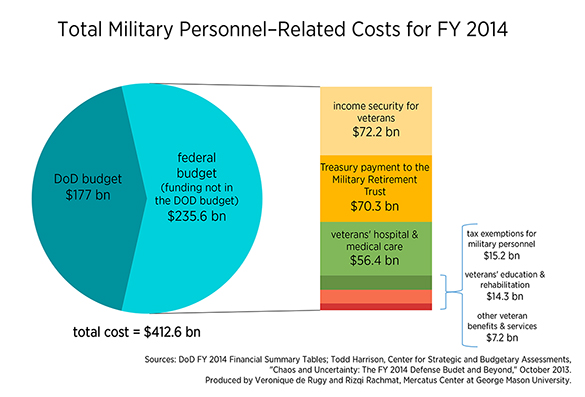- | Government Spending Government Spending
- | Data Visualizations Data Visualizations
- |
Personnel Costs May Overwhelm Department of Defense Budget
This week’s chart uses data from the Department of Defense’s FY 2014 budget request and an analysis by Todd Harrison of the Center for Strategic and Budgetary Assessments to display DoD outlays and personnel costs for 2014. If current trends hold, personnel costs on health care, income, and retirement may consume larger portions of the DoD budget with each succeeding year.
While most Americans are cognizant of the pressures that rising health costs place on big-ticket budget items like Medicare and Social Security, defense spending is often framed strictly in terms of military action. The same pressures that strain the general federal budget also affect military funding, but its opaque nature obscures rising health care and retirement costs for military personnel. If this trend in military spending continues, personnel costs—including health, income, and retirement spending—will consume unsustainable pluralities of defense spending.
This week’s chart uses data from the Department of Defense’s FY 2014 budget request and an analysis by Todd Harrison of the Center for Strategic and Budgetary Assessments to display DoD outlays and personnel costs for 2014. If current trends hold, personnel costs on health care, income, and retirement may consume larger portions of the DoD budget with each succeeding year.
The DoD budget is itemized into three broad categories: Operation and Support, which includes the subcategories of Operation and Maintenance and Military Personnel; Acquisition, which includes the subcategories of Procurement and Research and Development; and Infrastructure, which includes the subcategories of military construction and family housing. Additionally, the off-budget “Overseas Contingency Operations” (OCO) fund, which is not subject to Budget Control Act spending caps, funds overseas military operations outside of the DoD’s “official” budget.
The DoD budget is generally presented by listing the major categories and subcategories (without OCO funding) and summing the total. However, this method conceals the size of personnel spending. For instance, $218.7 billion in spending categorized as “Operation and Maintenance” funds health care services and pharmaceuticals administered by the Military Health System. Civilian personnel costs, too, are categorized as “Operation and Maintenance” spending rather than “Military Personnel” spending. This concealed personnel spending represents a considerable portion of the spending categorized as “Operation and Maintenance.”
Once the budget categories are broken down to distinguish personnel spending from the rest, the picture looks quite different. On-budget personnel costs will total $177 billion in 2014. The largest personnel category, basic pay, amounts to $51.9 billion. This amount is supplemented by $28 billion in allowances for service members to fund housing and general subsistence, $5 billion in special incentive pay, and $2.3 billion for recruiting and reenlistment bonuses. Health care costs, too, are a big budget item, with $33 billion in spending allocated in the Military Health System in 2014.
A CBO analysis of trends in DoD spending is sobering. Their projection of DoD spending under three different budget scenarios shows that military personnel spending on compensation and non-compensation will grow to the largest budget item by 2022 if action is not taken. Rising expected health care expenditures lead this growth in overall personnel costs; the Military Health System alone is expected to spend roughly $70 billion by 2022. While the CBO notes that growth in health care costs is likely to eventually decelerate, they project that this won’t occur until 2030 or later. Barring major reform, this problem will likely persist for at least two expensive decades, adding to an already strained fiscal situation.
Examining the DoD’s on-budget personnel spending just scratches the surface of all military-related personnel spending. Harrison notes that most military personnel spending is actually funded outside of the DoD budget. The chart above displays the breakdown of off- and on-budget personnel costs.
Veteran care comprises a majority of off-DoD-budget military personnel spending, with $56.4 billion planned for veteran health care, $72.2 billion dedicated to veteran income security, $14.3 billion funding veteran education, training, and rehabilitation, and a remaining $7.2 billion to provide miscellaneous veteran benefits. The Treasury Department’s payments for the Military Retirement Trust comprise a formidable $70.3 billion in spending, while tax exemptions for military personnel amount to another $15.2 billion in costs. All told, total military personnel spending will reach $412 billion in 2014, $235.4 billion of which is off the DoD’s official budget.
Proposals to control DoD’s spiraling health costs largely focus on shifting financial burdens to military personnel by raising enrollment fees, deductibles, or copayments. While these reforms likely are to be unpopular among the enlisted personnel, they merely tinker at the edges of the problem.
Ballooning personnel costs are merely a symptom of the larger problems of open-ended conflict and general health care price inflation. Until those catalysts are addressed, the DoD will need to make many tough budget choices to accommodate this growing liability. As long as it fails to do so, the US military may spend more of its resources providing benefits packages and less of its resources providing defense.



